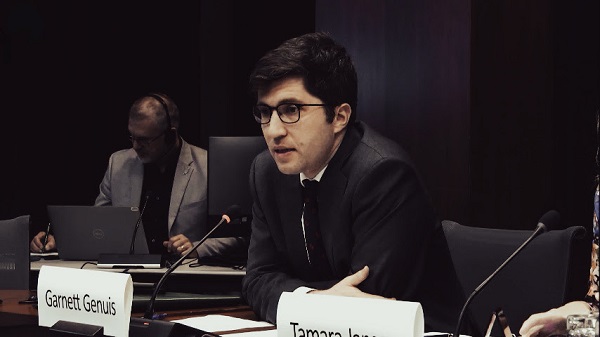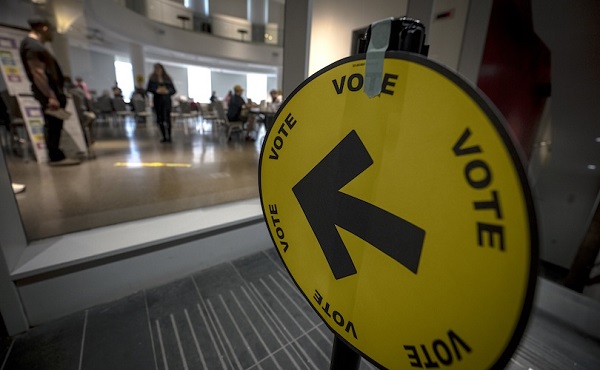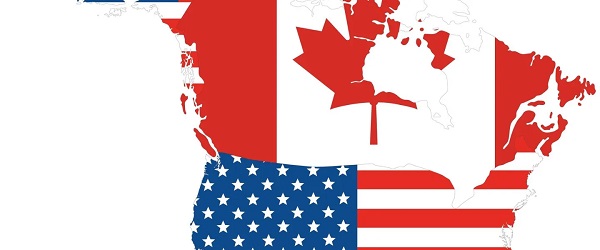Canadian Energy Centre
New deal with global gas giant Shell shows Canada is on the map for LNG: specialist
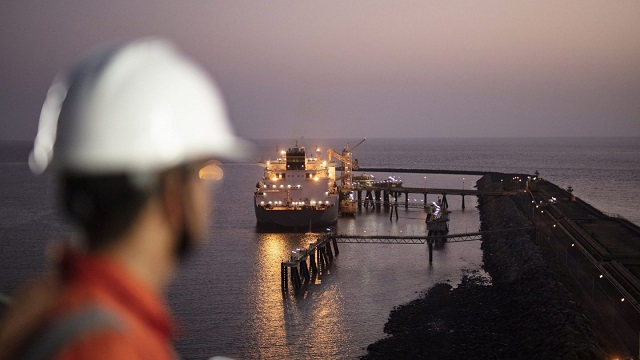
A worker at Shell’s Hazira LNG import terminal, about 250 kilometers from Mumbai, India. Photo courtesy Shell
From the Canadian Energy Centre
By Deborah Jaremko‘This is a signal that the LNG demand is viable beyond 2050’
A new 20-year deal by global energy giant Shell to purchase liquefied natural gas (LNG) from British Columbia is a sign Canada is becoming a player in global LNG markets, says an industry specialist.
Shell has agreed to buy two million tonnes of LNG per year from the proposed Ksi Lisims LNG project located near the Alaska border, which could start operating in 2028.
“Canada is on the map now for LNG. This is a signal that the LNG demand is viable beyond 2050,” says Racim Gribaa, president of Calgary-based Global LNG Consulting.
Gribaa has worked in energy for more than two decades, engaging with governments and industry on LNG developments around the world including Malaysia, the United States, Canada and Qatar.
Long-term LNG deals like the one struck by Ksi Lisims and Shell are hard to come by, he says, and are a sign that so-called LNG “portfolio players” trust the ability of Canada’s natural gas industry to deliver.
A portfolio player like Shell buys LNG from various suppliers and distributes it to buyers around the world – versus a buyer that purchases LNG solely for its own use.
“When portfolio players buy LNG, it’s not necessarily for a specific country. They can sell it anywhere they want,” Gribaa says.
“Canada’s west coast can enable them to sell cargo to efficiently meet demand in Asia without having to ship it all the way from farther locations. Instead of them shipping cargo from the Middle East, Europe, or from the U.S. thereby avoiding longer journeys around the Cape or going through the Strait of Hormuz or Panama Canal, instead they just send it straight from Canada to where they need it to go. It’s economically and logistically beneficial for them.”
Driven by expanding economies in Asia, world LNG trade has increased by more than 200 per cent since 2000, reaching 401 million tonnes in 2022, according to the International Gas Union.
Global natural gas use is rising, driving increased demand for LNG. The U.S. Energy Information Administration’s latest outlook projects natural gas consumption will rise to 197 quadrillion BTU in 2050, up from 153 quadrillion BTU in 2022.
In addition to the deal with Ksi Lisims owners including the Nisga’a Nation, Shell is also lead owner of the LNG Canada project, which is nearing completion at Kitimat, B.C.
The terminal will have capacity of 14 million tonnes per year when it starts up in 2025. The buyers of the exports from LNG Canada are its owners, including Shell and Petronas.
Shell’s decision to purchase LNG from Ksi Lisims could ensure it has plentiful supply available regardless of the timeline of the second phase of LNG Canada, Gribaa says.
“For a portfolio player, having options is valuable. We have enough demand globally to meet both Ksi Lisims LNG and LNG Canada phase 2, especially as coal is gradually faded out from Asia’s power mix,” he says.
“The only viable solution is to replace it with natural gas through LNG, as well as renewables, so the demand is forecast to be strong for several decades to come.”
Growing Canada’s LNG exports to Asia could reduce emissions by 188 million tonnes per year, or the annual equivalent of taking all internal combustion engine vehicles off Canadian roads, according to a 2022 study by Wood Mackenzie.
Down the coast from LNG Canada at Squamish, B.C. another major portfolio player is leaning on Canadian LNG.
BP Gas Marketing is the foundational customer for the Woodfibre LNG project, where early construction is underway.
Over a 15-year period, BP will purchase 1.95 million tonnes of the project’s 2.1 million tonne per year LNG capacity, and the remaining 0.15 million tonnes per year “on a flexible basis.”
“When you have such commercial commitments inked, it provides a future perspective on supply and demand, and perhaps most importantly it asserts the importance of Canada’s role in providing the world with a clean, affordable and secure long term LNG supply,” Gribaa says.
Alberta
Busting five myths about the Alberta oil sands
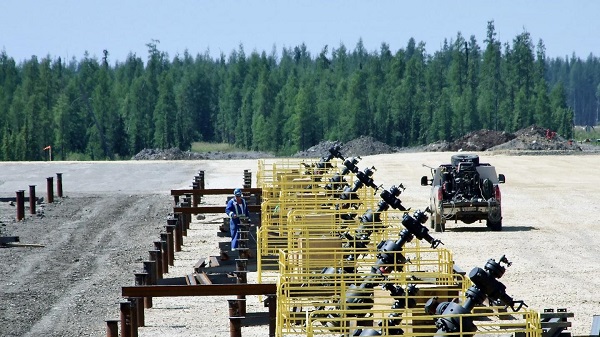
Construction of an oil sands SAGD production well pad in northern Alberta. Photo supplied to the Canadian Energy Centre
From the Canadian Energy Centre
The facts about one of Canada’s biggest industries
Alberta’s oil sands sector is one of Canada’s most important industries — and also one of its most misunderstood.
Here are five common myths, and the facts behind them.
Myth: Oil sands emissions are unchecked

Steam generators at a SAGD oil sands production site in northern Alberta. Photo courtesy Cenovus Energy
Reality: Oil sands emissions are strictly regulated and monitored. Producers are making improvements through innovation and efficiency.
The sector’s average emissions per barrel – already on par with the average oil consumed in the United States, according to S&P Global – continue to go down.
The province reports that oil sands emissions per barrel declined by 26 per cent per barrel from 2012 to 2023. At the same time, production increased by 96 per cent.
Analysts with S&P Global call this a “structural change” for the industry where production growth is beginning to rise faster than emissions growth.
The firm continues to anticipate a decrease in total oil sands emissions within the next few years.
The Pathways Alliance — companies representing about 95 per cent of oil sands activity — aims to significantly cut emissions from production through a major carbon capture and storage (CCS) project and other innovations.
Myth: There is no demand for oil sands production

Expanded export capacity at the Trans Mountain Westridge Terminal. Photo courtesy Trans Mountain Corporation
Reality: Demand for Canadian oil – which primarily comes from the oil sands – is strong and rising.
Today, America imports more than 80 per cent more oil from Canada than it did in 2010, according to the U.S. Energy Information Administration (EIA).
New global customers also now have access to Canadian oil thanks to the opening of the Trans Mountain pipeline expansion in 2024.
Exports to countries outside the U.S. increased by 180 per cent since the project went into service, reaching a record 525,000 barrels per day in July 2025, according to the Canada Energy Regulator.
The world’s appetite for oil keeps growing — and it’s not stopping anytime soon.
According to the latest EIA projections, the world will consume about 120 million barrels per day of oil and petroleum liquids in 2050, up from about 104 million barrels per day today.
Myth: Oil sands projects cost too much
Reality: Operating oil sands projects deliver some of the lowest-cost oil in North America, according to Enverus Intelligence Research.
Unlike U.S. shale plays, oil sands production is a long-life, low-decline “manufacturing” process without the treadmill of ongoing investment in new drilling, according to BMO Capital Markets.
Vast oil sands reserves support mining projects with no drilling, and the standard SAGD drilling method involves about 60 per cent fewer wells than the average shale play, BMO says.
After initial investment, Enverus says oil sands projects typically break even at less than US$50 per barrel WTI.
Myth: Indigenous communities don’t support the oil sands

Chief Greg Desjarlais of Frog Lake First Nation signs an agreement in September 2022 whereby 23 First Nations and Métis communities in Alberta acquired an 11.57 per cent ownership interest in seven Enbridge-operated oil sands pipelines for approximately $1 billion. Photo courtesy Enbridge
Reality: Indigenous communities play an important role in the oil sands sector through community agreements, business contracts and, increasingly, project equity ownership.
Oil sands producers spent an average of $1.8 billion per year with 180 Indigenous-affiliated vendors between 2021 and 2023, according to the Canadian Association of Petroleum Producers.
Indigenous communities are now owners of key projects that support the oil sands, including Suncor Energy’s East Tank Farm (49 per cent owned by two communities); the Northern Courier pipeline system (14 per cent owned by eight communities); and the Athabasca Trunkline, seven operating Enbridge oil sands pipelines (~12 per cent owned by 23 communities).
These partnerships strengthen Indigenous communities with long-term revenue, helping build economic reconciliation.
Myth: Oil sands development only benefits people in Alberta
Reality: Oil sands development benefits Canadians across the country through reliable energy supply, jobs, taxes and government revenues that help pay for services like roads, schools and hospitals.
The sector has contributed approximately $1 trillion to the Canadian economy over the past 25 years, according to analysis by the Macdonald-Laurier Institute (MLI).
That reflects total direct spending — including capital investment, operating costs, taxes and royalties — not profits or dividends for shareholders.
More than 2,300 companies outside of Alberta have had direct business with the oilsands, including over 1,300 in Ontario and almost 600 in Quebec, MLI said.
Energy products are by far Canada’s largest export, representing $196 billion, or about one-quarter of Canada’s total trade in 2024, according to Statistics Canada.
Led by the oil sands, Canada’s energy sector directly or indirectly employs more than 445,000 people across the country, according to Natural Resources Canada.
Alberta
Enbridge CEO says ‘there’s a good reason’ for Alberta to champion new oil pipeline

Enbridge CEO Greg Ebel. The company’s extensive pipeline network transports about 30 per cent of the oil produced in North America and nearly 20 per cent of the natural gas consumed in the United States. Photo courtesy Enbridge
From the Canadian Energy Centre
B.C. tanker ban an example of federal rules that have to change
The CEO of North America’s largest pipeline operator says Alberta’s move to champion a new oil pipeline to B.C.’s north coast makes sense.
“There’s a good reason the Alberta government has become proponent of a pipeline to the north coast of B.C.,” Enbridge CEO Greg Ebel told the Empire Club of Canada in Toronto the day after Alberta’s announcement.
“The previous [federal] government’s tanker ban effectively makes that export pipeline illegal. No company would build a pipeline to nowhere.”
It’s a big lost opportunity. With short shipping times to Asia, where oil demand is growing, ports on B.C.’s north coast offer a strong business case for Canadian exports. But only if tankers are allowed.
A new pipeline could generate economic benefits across Canada and, under Alberta’s plan, drive economic reconciliation with Indigenous communities.
Ebel said the tanker ban is an example of how policies have to change to allow Canada to maximize its economic potential.
Repealing the legislation is at the top of the list of needed changes Ebel and 94 other energy CEOs sent in a letter to Prime Minister Mark Carney in mid-September.
The federal government’s commitment to the tanker ban under former Prime Minister Justin Trudeau was a key factor in the cancellation of Enbridge’s Northern Gateway pipeline.
That project was originally targeted to go into service around 2016, with capacity to ship 525,000 barrels per day of Canadian oil to Asia.
“We have tried to build nation-building pipelines, and we have the scars to prove it. Five hundred million scars, to be quite honest,” Ebel said, referencing investment the company and its shareholders made advancing the project.
“Those are pensioners and retail investors and employees that took on that risk, and it was difficult,” he said.
For an industry proponent to step up to lead a new Canadian oil export pipeline, it would likely require “overwhelming government support and regulatory overhaul,” BMO Capital Markets said earlier this year.
Energy companies want to build in Canada, Ebel said.
“The energy sector is ready to invest, ready to partner, partner with Indigenous nations and deliver for the country,” he said.
“None of us is calling for weaker environmental oversight. Instead, we are urging government to adopt smarter, clearer, faster processes so that we can attract investment, take risks and build for tomorrow.”
This is the time for Canadians “to remind ourselves we should be the best at this,” Ebel said.
“We should lead the way and show the world how it’s done: wisely, responsibly, efficiently and effectively.”
With input from a technical advisory group that includes pipeline leaders and Indigenous relations experts, Alberta will undertake pre-feasibility work to identify the pipeline’s potential route and size, estimate costs, and begin early Indigenous engagement and partnership efforts.
The province aims to submit an application to the Federal Major Projects Office by spring 2026.
-

 MAiD2 days ago
MAiD2 days agoDisabled Canadians increasingly under pressure to opt for euthanasia during routine doctor visits
-

 Business12 hours ago
Business12 hours ago$15B and No Guarantees? Stellantis Deal explained by former Conservative Shadow Minister of Innovation, Science and Technology
-

 Agriculture13 hours ago
Agriculture13 hours agoFrom Underdog to Top Broodmare
-

 Digital ID1 day ago
Digital ID1 day agoThousands protest UK government’s plans to introduce mandatory digital IDs
-

 Alberta24 hours ago
Alberta24 hours agoAlberta’s licence plate vote is down to four
-

 Bruce Dowbiggin23 hours ago
Bruce Dowbiggin23 hours agoIs The Latest Tiger Woods’ Injury Also A Death Knell For PGA Champions Golf?
-

 Digital ID2 days ago
Digital ID2 days agoToronto airport requests approval of ‘digital IDs’ for domestic airport travel
-

 Business1 day ago
Business1 day ago“Modernization,” They Call It: How Ottawa Redefined Fraud as Progress




